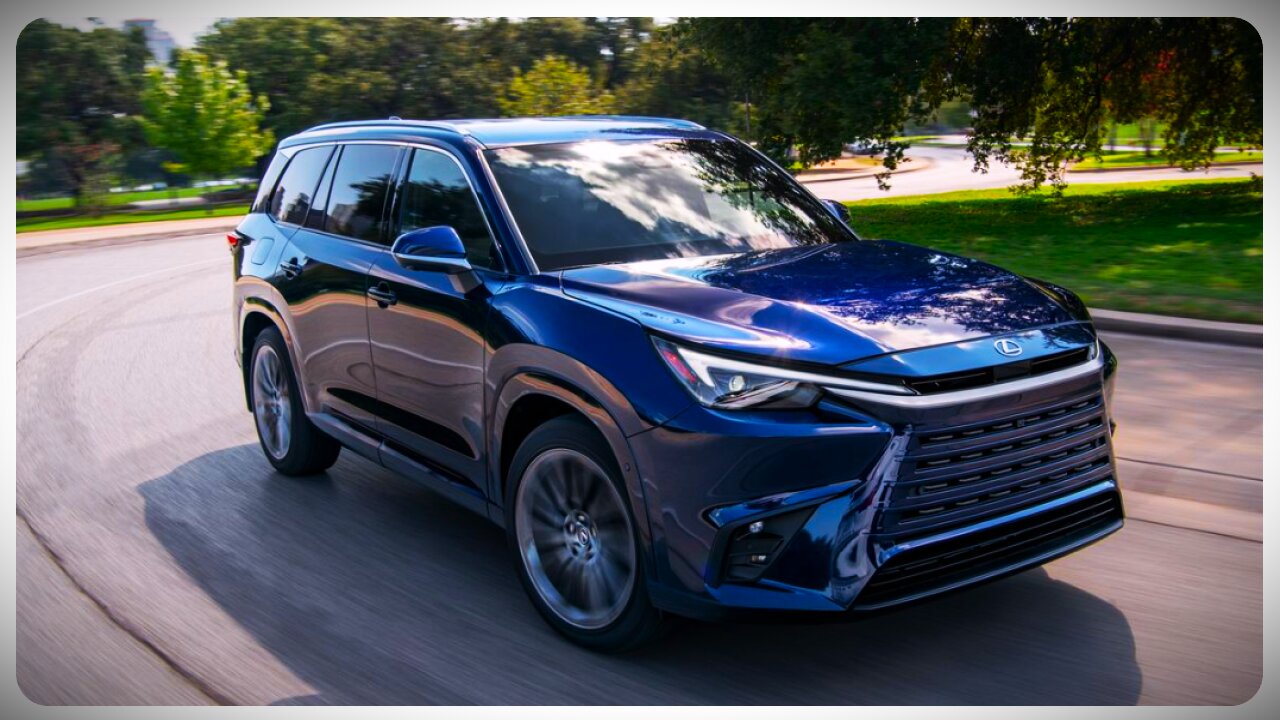Premium Only Content

NEW LEXUS TX 2024 #car_2024 #lexus #tx #new_car
NEW LEXUS TX 2024 #car_2024 #lexus #tx #new_car
It's a testament to the success of the RX that Lexus was able to dominate the luxury-crossover.
Built on the same platform as the Toyota Grand Highlander, the TX is significantly bigger than the latest RX, with a nearly four-inch longer wheelbase, almost three inches of extra width, and just over a 203-inch overall length. There's no swoopy roofline to be found here, as the squared-off rear end makes it clear the TX is a people hauler that places function over form.
Space for passengers and cargo is important in this segment, and that's what the TX delivers. No matter whether you choose the seven-passenger configuration with a second-row bench or the six-passenger setup with captain's chairs, all three rows are habitable for adults. The only real flaw in the rearmost seat is the low bottom cushion, but that's true of most of the TX's rivals, and at least Lexus offers a recline function along with armrests and USB ports.
The environs up front will be familiar to anyone who has driven the new RX, with a large 14.0-inch touchscreen dominating the dash and a muted design without many flashy touches. Many premium vehicles have interiors that look better than they feel, but the latest Lexus cabins are the opposite, with lots of plush touch points and high-quality materials but little visual flair or panache. We found the touchscreen to be relatively clear and easy to use, but certain functions—such as the drive mode selector—are buried deeper in settings menus than we'd like. The touch-sensitive control pads on the steering wheel that display their selections on the head-up display are also not the most intuitive.
While many competitors offer merely a turbo four or a V-6 engine, Lexus is offering a wide range of powertrain choices in the TX, including two hybrids. The base TX350 has a 275-hp turbocharged 2.4-liter inline-four that provides merely adequate grunt for a big vehicle like this. We expect a 60-mph time in the 7.0-second neighborhood, slightly quicker with the optional all-wheel drive, but both of which are not standout times for this class. The turbo four is relatively well isolated from the cabin, but its occasionally grumbly tone makes us miss the smoothness of Lexus's naturally aspirated 3.5-liter V-6—though it was also a bit sluggish and didn't provide great fuel economy.
Things get more interesting with the 366-hp TX500h, a hybrid that comes exclusively with the F Sport Performance treatment. Its combination of the turbo four with front and rear electric motors is nearly identical to the Hybrid Max system available in the Grand Highlander, and it's similarly impressive here. We enjoyed hustling the TX500h through corners, as the powertrain is quick and responsive and the F Sport's standard adaptive dampers tighten up the body motions, making the TX a surprisingly eager handler for its size. The tradeoff is ride quality, as the F Sport model is a bit too firm for this vehicle's mission.
-
 1:09:09
1:09:09
Omar Elattar
7 hours agoThe Brain Experts: Your Brain Can Rewire Itself At Any Age & Here's How!
12.5K3 -
 LIVE
LIVE
IcyFPS
3 hours agoLIVE - Wuchang Fallen Feathers x Borderlands w/ pope!
373 watching -
 29:24
29:24
Afshin Rattansi's Going Underground
17 hours agoWas Epstein a Mossad Agent? Will Obama go to Prison? (Afshin Rattansi vs Alan Dershowitz)
21.2K21 -
 4:26:54
4:26:54
Nerdrotic
10 hours ago $29.20 earnedFantastic Four Baby Steps V Superman's James Gunn, South Park Returns | Friday Night Tights 364
106K8 -
 3:17:40
3:17:40
megimu32
4 hours agoOFF THE SUBJECT: FAFO Friday! Cops, Crash, Kombat & Chaos!
21.2K5 -
 10:17:28
10:17:28
GrimmHollywood
13 hours ago🔴LIVE • GRIMM HOLLYWOOD • CLIP FARMING 101 •
17.9K1 -
 1:07:56
1:07:56
Glenn Greenwald
10 hours agoIsrael-Made Famine Crisis Finally Recognized | SYSTEM UPDATE #493
104K58 -
 2:29:42
2:29:42
TheSaltyCracker
5 hours agoGhislaine Maxwell Talks ReEEeStream 7-25-25
91.3K180 -
 9:27
9:27
MattMorseTV
8 hours ago $3.31 earnedHe just lost EVERYTHING.
26.5K11 -
 5:52:21
5:52:21
a12cat34dog
6 hours agoSPOOKY ASS 2005 GAME :: F.E.A.R. :: FIRST-TIME FINISHING THIS CLASSIC {18+}
8.74K5